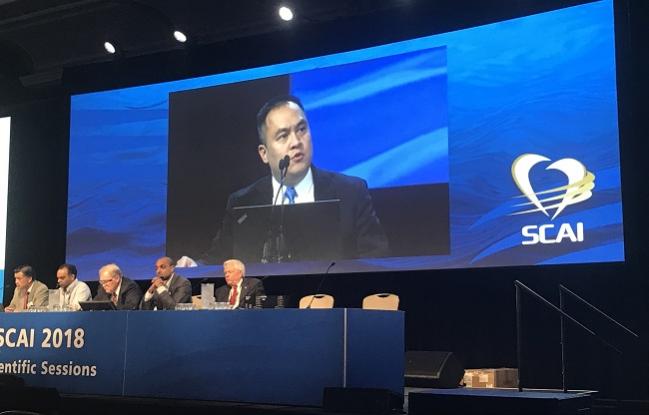FLARE Trial: Novel Device Safe and Efficacious for Catheter-Derived Mechanical Thrombectomy in PE
In the multicenter study, the device was shown to restore flow into the pulmonary artery and lower ventricular strain without thrombolytics.

SAN DIEGO, CA—Percutaneous mechanical thrombectomy that avoids use of thrombolytic therapy can improve RV/LV ratio in patients with pulmonary embolism (PE), according to results of the FLARE study.
At the Society for Cardiovascular Angiography and Interventions 2018 Scientific Sessions, study presenter Thomas Tu, MD (Baptist Health, Louisville, KY), said he believes the novel device is safe and effective in acutely improving RV function in patients with intermediate-risk pulmonary embolism.
“I think it potentially has the chance to reduce bleeding complications, [and] reduce total hospital and ICU length of stay,” he added in a press conference with reporters ahead of his presentation.
Although there is evidence that catheter-directed thrombolysis can be effective in the treatment of this patient group, Tu said the requirement for anticoagulants and thrombolytics and the concomitant risk of bleeding make the newer device an attractive treatment option.
Few Major Adverse Events Seen
FLARE was a multicenter, single-arm IDE study that included 106 patients with intermediate-risk pulmonary embolism. All were treated with the Flowtriever system (Inari Medical, Irvine, CA), which consists of an aspiration catheter that is advanced through the veins into the pulmonary artery, and disks that are used to engage the clot and withdraw it back into the catheter. Patients with thrombolytic therapy use in the previous 30 days were excluded, but there was no specific exclusion for increased bleeding risk.
Mean procedural time was 1 hour 39 minutes. More than 80% of patients received unfractionated heparin, 95% of procedures were right femoral access, and there were no technical complications.
When RV/LV ratios were assessed at 48 hours postprocedure, there was a reduction of 0.39, which represented a significant decline from baseline (mean, 1.53 to 1.15; P < 0.0001). The difference remained significant even after exclusion of patients without measurable endpoints or other statistical anomalies.
Median ICU stay was 1 day, although 44 patients of the 106 patients spent no time in ICU. Median time to discharge was 3 days after the procedure. Four patients (3.8%) had major adverse events, which consisted of coughing up blood, worsening of PE, cardiogenic shock, and respiratory arrest in an agitated patient. There were no instances of intracranial hemorrhage, access-site VARC-2 major bleeding, or device-related deaths or injuries.
Tu noted that while it is not possible to accurately compare the device across other trials that have investigated catheter-derived treatment of PE, the safety compares favorably, as does the reduction in right-ventricular-to-left-ventricular ratio at 48 hours.
Learning Curves and Applicability
Following Tu’s presentation, he was asked about the facility of the procedure.
“There’s definitely a learning curve,” he noted. “We had three patients who had clinical deterioration as a result of the procedure, and if you look at when that occurred, it was all within the first five procedures.” He said he has personally performed 120 of these procedures and now averages less than 60 minutes per case. Experienced interventionalists, he noted, can probably become proficient after using the device in five cases.
Panelist Charles E. Chambers, MD (Milton S. Hershey Medical Center, PA), asked Tu about the practical application of the device, given the positive results.
“I think the practical next step is obviously to get an FDA indication for this device, and once there is an FDA indication I think a very focused rollout to high-quality PE centers who want a nonthrombolytic tool for treatment of PE is important,” Tu said. “This tool is very safe and very effective as evidenced by the study, but I do think there are some hard lessons that have been learned and it’s important to communicate those clearly. I don’t think this is something that should be put on every cath lab shelf just yet.”
L.A. McKeown is a Senior Medical Journalist for TCTMD, the Section Editor of CV Team Forum, and Senior Medical…
Read Full BioSources
Tu T. Prospective, single-arm, multicenter trial of catheter-directed mechanical thrombectomy for intermediate-risk acute pulmonary embolism: the FLARE study. Presented at: SCAI 2018. April 27, 2018. San Diego, CA.
Disclosures
- Tu reports no relevant conflicts of interest.


Comments